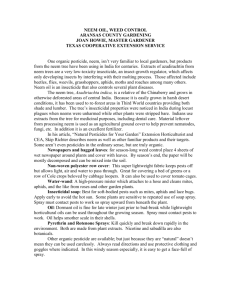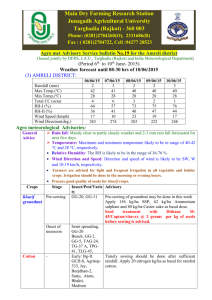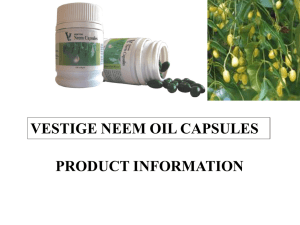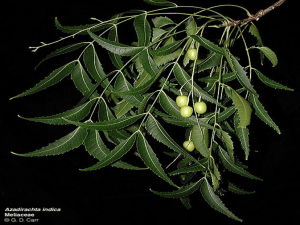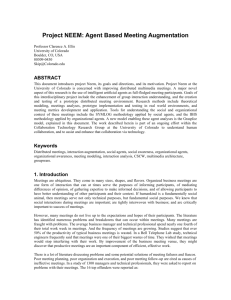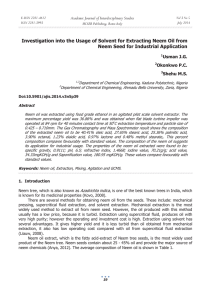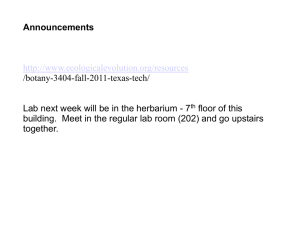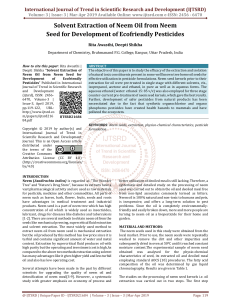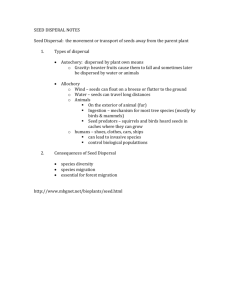NeemSeedOil
advertisement
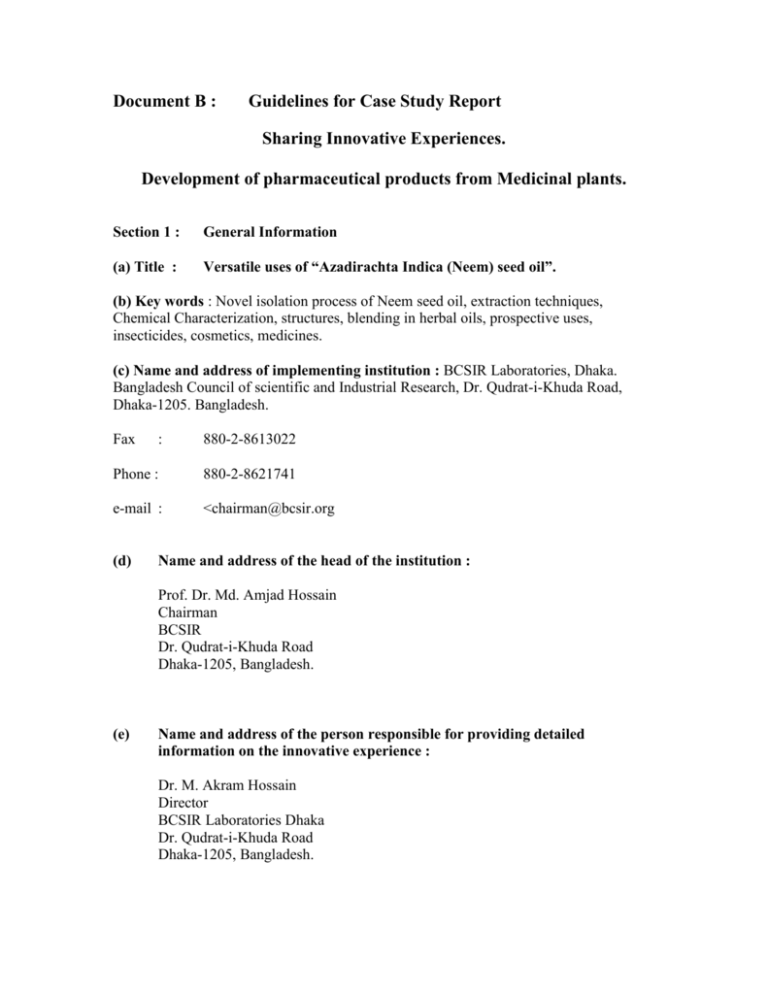
Document B : Guidelines for Case Study Report Sharing Innovative Experiences. Development of pharmaceutical products from Medicinal plants. Section 1 : General Information (a) Title : Versatile uses of “Azadirachta Indica (Neem) seed oil”. (b) Key words : Novel isolation process of Neem seed oil, extraction techniques, Chemical Characterization, structures, blending in herbal oils, prospective uses, insecticides, cosmetics, medicines. (c) Name and address of implementing institution : BCSIR Laboratories, Dhaka. Bangladesh Council of scientific and Industrial Research, Dr. Qudrat-i-Khuda Road, Dhaka-1205. Bangladesh. Fax : 880-2-8613022 Phone : 880-2-8621741 e-mail : <chairman@bcsir.org (d) Name and address of the head of the institution : Prof. Dr. Md. Amjad Hossain Chairman BCSIR Dr. Qudrat-i-Khuda Road Dhaka-1205, Bangladesh. (e) Name and address of the person responsible for providing detailed information on the innovative experience : Dr. M. Akram Hossain Director BCSIR Laboratories Dhaka Dr. Qudrat-i-Khuda Road Dhaka-1205, Bangladesh. 2 (f) Individual involve in the innovative experience with a brief indication of their role in developing the experience. Mr. Gour Chardra Saha Mrs. Monowara Begum Mrs. Feroza Begum Mrs. Katrun Nada Prof. Dr. Md. Amjad Hossain (g) Implementation period and total cost (express in US $) of the project (List contribution receive from Government, private sector and foreign sources). From July 2002 to June 2005 Total cost approximately US$ 5000 received from R&D fund, BCSIR. Section 2 (a) : Summary of the Innovative Experience Non-technical summary of the main features of the project )high light the innovative aspects and the main results achieved). Fatty oil (38%) was extracted from the crushed seed of Neem by extraction with light petroleum ether (40-600C). The crude oil was investigated for its physico-chemical characteristics and this was subjected to esterification using methanol and pure sodium hydroxide. The fatty acid composition of the resulting esters was established by Gas liquid Chromatography (GLC). Palmitic, stearic, oleic linoleic and arachidic acids were found to be main fatty acids in the oil. 3 Section 3 : Background and justification (a) Brief description of the situation before the innovative experience. Bangladesh is blessed with a lot of medicinal plants. Neem is one of the most important medicinal plants abundantly available in Bangladesh and also in the sub-continent. The tree is large, evergreen, 12-18m in height and 1.8-2.4 in girth. Almost every part of the tree is bitter and finds application in indigenous medicine. Neem extracts have been reported to possess antidiabetic, antibacterial and antiviral properties and they have been used successfully in cases of stomach worms and ulcers. Tender twigs are used to clean teeth, particularly useful in pyorrhoea. The essential oil from the leaves possesses marked antiseptic and antibacterial properties and inhibits the growth of mycobacterium tuberculosis. The leaves are variously used as an insect repellent. The fatty oil of Neem seed has many therapeutic uses. It possesses antiseptic and antifungal activity and is found to be active against both grampositive and gramnegative organisms. Considerable quantities of the oil are employed in cosmetic preparations such as creams, soaps, tooth powder and tooth pastes. In the present field of investigation with find that the neem seed oil isolated from the local variety are separated by Gas liquid chromatography (GLC) is a unique experience indications the possibilities of a large number of vitally important applications in our economy. (b) Justification and context of the innovation experience (1) To extract fixed and essential oils from Neem seed using an adjusted technique so that maximum amounts of component fatty acids including essential fatty acids can be obtained. (2) To determine whether the fixed seed oil can be used as edible oil by eliminating bitter and other ingredients. (3) To incorporate into a base oil like linseed oil, turmeric oil palmarosa oil, mustard oil and if one or more medicated oils can be processed for use in medicines as body or hair oils. (c) Main issues involved. The work will involve separation of oil fractions using tlc, glc, ir, spectrophotometry, refractometry and other testing and quantitative methods. 4 Section 4 : (a) Description Detailed description of the experience The Neem seeds were collected from the matured plants during April-August from BCSIR, Dhaka Campus. The seeds were thoroughly cleaned and carefully dried in the sun. The dry seeds were crushed to a powder. The powder was exhaustively extracted with petroleum ether (40-600C) in a soxhlet. The solvent was removed and a brown oil ( 38% of the powder weight ) was obtained. The oil was then analysed for its different physical and chemical properties. These are separately shown in table I. The fraction available in the mixture were identified to be palmitic, stearic, oleic, linoleic and arachidic acid. A very fine quality face cream has been developed using the crude oil. (b) Steps taken in the innovative and implementation process. Preparation of methyl esters of Neem seed oil 100mg of Neem seed oil was taken in a pear-shaped flask. 4ml of 0.5 N methanolic Sodium hydroxide solution was added to the oil. A condenser was attached with it and reflex for 10 minutes. Then 5ml Boron trifluoride-methanol (BF3 – CH3OH) complex added from a bulb pipette through condenser and continued boiling for 2 minutes 5ml of Hexane was added through condenser and boiled for another 1 minute. Then hot mixture was poured into a small separatory funnel with 10ml of hexane. The mixture was diluted with 5ml of water. The hexane layer was separated, dried over anhydrous sodium sulphate and filtered. The solvent was evaporated by reduced pressure and transferred to a vial. To methyl ester of the oil was used fatty acid analysis by Gas liquid Chromatography (GLC). Gas liquid chromatography of Methyl esters. To determine the fatty acids composition of methyl esters obtained by methylation of Neem seed oil, Pye Unicam GC-304 chromatograph, with dual flame ionization detector was used. The glass column (2000mm 4mm): temperature maintained at 2300 – 2500C glycol succinate (DEGS) on 100-120 mesh. To prepare the stationary phase usual procedure adapted, chloroform was the solvent, Nitrogen was used as a carrier gas, flow rate 30ml/min, column temperature, injector and detector were 1900C, 2000C and 1950C respectively. The speed of the recorder was 2.5mm/min. Both internal and external standard were used for identification of individual fatty acid. The fatty acids composition of the oil was tabulated in Table II. 5 (c) Technical data including diagrams, charts, tables,photographs, etc. (if any) Tables are given. Table 1 : Physico-chemical properties of Neem oil Properties Value 1. Physical appearance Pale green liquid 2. Smell/odour Pungent but agreeable 3. Density (gm/cc at 310C) 0.91574 (0.9087) 4. Refractive index (at 310C) 1.4649(1.4612) 5. Melting point (0C) 23 6. Moisture content (%) 4.02 7. Acid value (%) 2.24(4.45) 8. Peroxide value (meq/kg) 7.81 9. Unsaponifiable matters (%) 1.31(1.26) 10. Saponification value 190.80 (290.9) 12. Iodine value 134.70 (66.4) On dehulled seed basis ( ) indicates value reported in literature 6 Table 2 : Proximate Fatty Acid Composition Components obtained Fatty acid (%) RT Palmitic acid 18.45 18.69 Stearic acid 0.20 19.36 Oleic acid 58.50 20.68 Linoleic acid 21.00 20.86 Arachidic acid 1.50 22.51 Results obtained from GC Table 3 : Essential Oil From Neem Leaf Analysis Results 1. Steam Volatiles/Essential oil (%) 0.4 2. Physical appearance Pale yellow liquid. 3. Smell / Odour Characteristic odour of neem. 7 Section 5 : Partnership (a) Public/community stockholder and private sector involvements and strengthening weaknesses between partners (if any) None (b) Other regional and international collaborators (if any) None Section 6 : Replicability (a) Relevance of the innovative experience to other regions Not known (b) Policy implication (if any) None Section 7 : Impact (a) Quantitative and / or qualitative impact of the experience after implementation (Indicators of success) Considerable quantities of the oil are employed in cosmetics preparations such as cream, soaps and tooth paste. (b) Sustainability of the innovative experience (economic, environmental ,social) Neem has been termed as a versatile tree with immense potential to protect the environment as well as could be disseminated to a viable agriculture. It has been reported that 2 Neem trees in a home stead of a family could earn US$ 800/= in a year, by selling various parts of the tree. So its viability in uplifting socioeconomic development of any third world nation is very important to contemplate. 8 (c) What special circumstances exist which made the experience successful. The products are successfully developed so far in this field are (1) Neem based cream (2) Neem tooth paste. Section 8 : Lessons learnt (a) Obstacles faced and steps taken to overcome them None (b) Preparing public perception for acceptance of the innovation. Since neem tree is well known innovation for its extensive medicinal importance since long and is popular to the people of tropical region, so its perception to the people is wide. Innovations of overall process could help people to accept easily in realizing the medicinal importance of the seed oil as well as its importance in developing family economy. Section 9 : Future plans (a) Plants for further improvement and expansion of the project Future plans to be undertaken after successful innovation are (1) To isolate active constituents from leaves, twigs, barks and roots. (2) Several bio essentials including anti oxidants like poly hydroxy phenols have been reported to be present in the afforsaid parts of the tree. (b) Plans for collaborations organizations/countries. and sharing of the results with other We have further plans to collaborate globally for sharing results and ideas with regard to the utilization of Neem. 9
